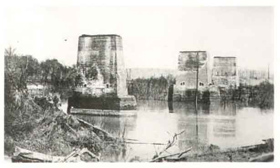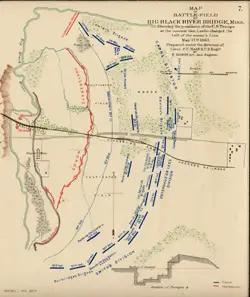Civil War Battles |
Colonial Wars |
American Wars |
Link To This Page — Contact Us —
The Battle of Big Black River Bridge
May 17, 1863 in Hinds & Warren County, Mississippi
Union Forces Commanded by:
Maj. Gen. John A. McClernand
Maj. Gen. John A. McClernand
| Forces | Killed | Wounded | Captured |
| - | 39 | 237 | 3 |
Confederate Forces Commanded by:
Brig. Gen. John S. Bowen
| Forces | Killed | Wounded | Captured |
| - | 600 k&w- | - | 2,000* |
**Missing and Captured
Conclusion: Union Victory

Ruins of the railroad bridge over the Big Black River near Bovina. The railroad bridge, as well as the boat bridge, was burned by the Confederates on May 17, 1863, to cover their retreat during the Battle of the Big Black.
BATTLE SUMMARY
On May 16, the 2 Confederate divisions mauled at Champion's Hill reached Big Black River Bridge during the night. Lt. Gen. John C. Pemberton, expecting Maj. Gen. William W. Loring's division to rejoin him, told Brig. Gen. John S. Bowen, with 3 brigades and 18 cannon, to hold the line of breastworks on the east side of the Big Black River and impede any Union pursuit..On May 17, in the morning, the Army of Tennessee resumed its advance from Champion's Hill. Three divisions of Maj. Gen. John A. McClernand's XIII Corps took the lead as columns tramped through Edward's Station. Miles beyond the village, Brig. Gen. Peter J. Osterhaus' vanguard emerged from a woods and saw earthworks to their front. The corps encountered the Confederates behind breastworks of cotton bales fronted by a bayou and abatis. They took cover as Confederate artillery began firing. Skirmishers were thrown forward, artillery called up, and Osterhaus deployed his division south of the road. As the Federals took position, the Confederate artillery opened fire.
Brig. Gen. Michael K. Lawler formed his 2nd Brigade, Brig. Gen. Eugene A. Carr’s 14th Division, which surged out of a meander scar, across the front of the Confederate forces, through waist-deep water, and into the breastworks, held by Brig. Gen. John Vaughn’s East Tennessee Brigade. McClernand posted Carr's brigades on Osterhaus' right. Brig. Gen. Stephen G. Burbridge's brigade of Brig. Gen. Andrew J. Smith's division then occupied the ground on Osterhaus' left.
Maj. Gen. Ulysses S. Grant determined to employ his other corps to turn the Confederate position. McPherson's corps was to bridge the Big Black at Amsterdam and Maj. Gen. William T. Sherman's at Bridgeport, while McClernand's men kept the Confederates pinned behind their fortifications.
More than 6 hours before "Union Pioneers" bridged the Big Black, Brig. Gen. Michael K. Lawler formed his 2nd Brigade, Carr's Division, which surged out of a meander scar, across the front of the Confederate forces, and into the breastworks, held by Vaughn's East Tennessee Brigade. Confused and panicked, the Confederates began to withdraw across the Big Black on 2 bridges: the railroad bridge and the steamboat, CSS Dot, dock moored athwart the river. As soon as they had crossed, the Confederates set fire to the bridges, preventing close Union pursuit.
The fleeing Confederates who arrived in Vicksburg later that day were disorganized. It was a mob rather than an army. The Union forces captured approximately 1,800 troops at Big Black, a loss that the Confederates could ill-afford. This battle sealed Vicksburg's fate: the Confederate force was bottled up at Vicksburg.
*Click on map to Enlarge

